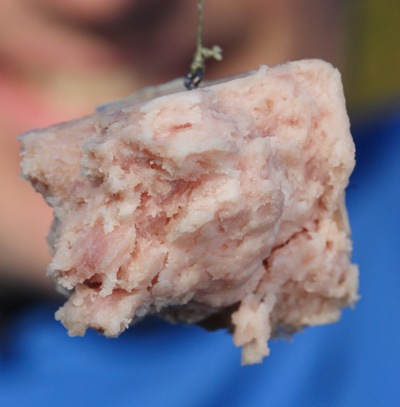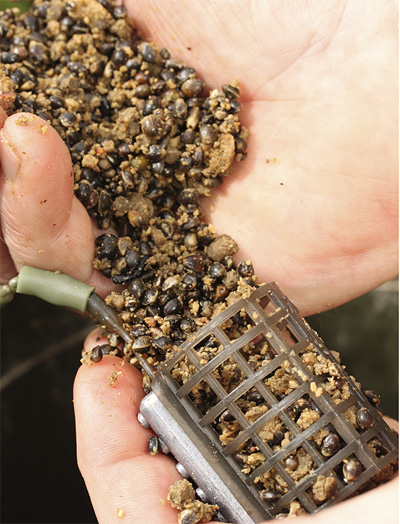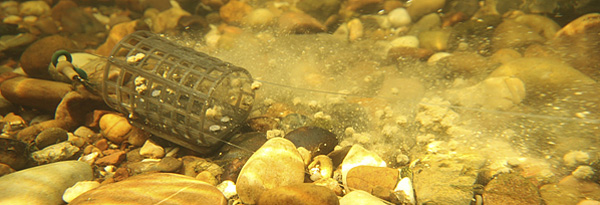Q. Can you explain rolling baits for barbel? I’ve tried it and always end up getting snagged and never know if I’ve had a bite. Everyone says to use meat but why can’t you use boilies or pellets?
Nick Watkins answers:
A lot of people have difficulty with rolling meat so you’re not alone. A lot depends on how you have set up your kit, water flow etc. If the line is too tight it will drag the bait across stream looking unnatural, if the line is too slack you will miss bites. It’s a fine balancing act.
I use a lump of Plasticine on the line rather than a shot if the water is snaggy or weedy, then if I get snagged or a fish runs into a weed bed the Plasticine can pull off instead of getting caught up, leaving me in contact with the fish. Another popular way of presenting is to use lead wire on the hook shank and no weight on the line.
 Make sure you bury the hook in the bait to stop it catching up on rocks and weed as it runs through and you need to cast upstream and across of where you are standing and let the meat bounce down towards you, holding the line in your free hand, this way you can feel for any little knocks and plucks on the line. The bait should be able to slowly bounce along the bottom, if it stops then gently lift the rod tip to make it roll on. Sometimes you can’t miss a take as a barbel will take off like a rocket, other times you might get a little pluck on the line. Let the bait continue bouncing along and feel for it, you might also see the line draw tight as the fish moves off.
Make sure you bury the hook in the bait to stop it catching up on rocks and weed as it runs through and you need to cast upstream and across of where you are standing and let the meat bounce down towards you, holding the line in your free hand, this way you can feel for any little knocks and plucks on the line. The bait should be able to slowly bounce along the bottom, if it stops then gently lift the rod tip to make it roll on. Sometimes you can’t miss a take as a barbel will take off like a rocket, other times you might get a little pluck on the line. Let the bait continue bouncing along and feel for it, you might also see the line draw tight as the fish moves off.
The further you cast upstream the further the bait can run through before being pulled off line, but this is a close range method, you won’t be casting 50 or 60 metres, the closer you can fish the better. If you have a clear bank then you can walk the meat along and cover a larger area.
You could feasibly use pellets of boilies but you would struggle to get the control you needed to make the method work. Part of the attraction of rolling meat is the fact the meat can bounce through, catch up and stop, then start moving again. This looks very natural in the water for the fish and a lot of the time you get a bite just after the bait has stopped then starts moving again. To control lighter baits such as pellets or boilies you would need more weight on the line and getting the presentation right would be very difficult.
Q. How often should I be re-casting into my barbel swim if I’m not getting any bites?
 Dave Pimlott answers:
Dave Pimlott answers:
As a general rule of thumb, if you are happy with your cast, the presentation is good and everything is looking right then I am happy leaving the rigs out for about 20 minutes. A shorter time, say ten minutes, may not be enough time for the barbel to settle on your feed and feel confident after the feeder or lead has entered the swim. Too long a time though, say 40 minutes, and the feed may have dispersed downstream and out of the swim taking the barbel with it.
There are exceptions, particularly on red letter days when casting more regularly can be an advantage. When the barbel are feeding strongly, a short recast of five minutes or less, can really pay dividends.
Alternatively, on hard days when you are effectively fishing for one bite with, usually, a big bait, it can be worth leaving the rig out for up to an hour or more before disturbing the swim and recasting.

The key thing is to think how your bait is dispersing on the river bed and try to keep some feed in the area to pull the fish in and get them feeding without casting so regularly that the fish are disturbed by the splash of the lead or feeder.
Any Questions?
With carp and specialist anglers of the calibre of Paul Garner, Tony Gibson, Alan Storey, Steve Pope, Ted Bryan, Alan Blair, Mark Barrett, Lewis Baldwin and Bernard Anderson – to name but a few – the Nash Peg One team has a wealth of experience covering just about every species that swims and the expertise of the whole team is on tap for everyone at FishingMagic to take advantage of in these Q and A sessions.
If you have any questions that you would like the team at Nash Peg One to answer in the next instalment then please e-mail them through to editor@fishingmagic.com










